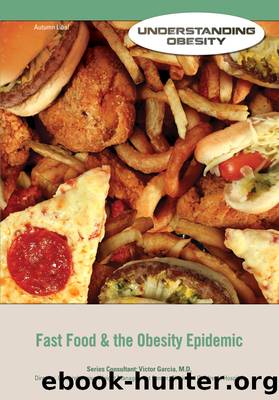Fast Food & the Obesity Epidemic by Autumn Libal

Author:Autumn Libal
Language: eng
Format: epub
Tags: Fast Food & the Obesity Epidemic
ISBN: 9781422288443
Publisher: National Highlights Inc
Published: 2015-01-15T00:00:00+00:00
Given the busy lifestyles most Americans now lead, however, one might ask, âIs Spurlockâs experiment really all that crazy?â Probably not many people eat at McDonaldâs three meals a day every day. But plenty of people rely on fast food (whether it is purchased in a grocery store, vending machine, or restaurant) for the majority of their meals. Think about it. How many people do you know who might grab an Egg McMuffin® for breakfast, a Subway sandwich for lunch, and a Taco Bell burrito for dinner? Still sound a little improbable? How about grabbing a Pop-Tart for breakfast, bringing two or three slices of leftover pizza to school for lunch, getting some chips and a Coke from the vending machine for a snack, and cooking frozen, storebought lasagna for dinner? Thatâs already a day of fast food without even setting foot in a fast-food restaurant.
Educating Yourself
Eating three meals a day at McDonaldâs isnât representative of the average American diet, but fast food is far more prevalent in our lives than many people realize. Even fewer people fully comprehend the risks associated with so many of these foods. In response to criticisms, fast-food restaurants claim that nutrition information is widely available to the public. Many people, however, still donât have access to that information because it appears on companiesâ Web sites but is rarely posted in their restaurants. How often do you have access to the Internet while standing in line to purchase fast food? Furthermore, there are still plenty of Americans who do not have access to the Internet in their homes.
So letâs educate ourselves. Letâs take some of the menu items offered by just a few of the industry leaders: McDonaldâs, Burger King, Subway, Pizza Hut, and Taco Bell.
The United States Food and Drug Administration (FDA) requires food manufacturers meet specific guidelines if they wish to place claims like âlow fat,â âlow cholesterol,â âhigh fiber,â âlow sodium,â âhealthy,â or others on their food labels. Look at the chart of FDA labeling requirements on page 61. Now examine the nutrition information for these fast foods. How many of them would meet the FDAâs requirements for these health claims?
If you visit these restaurantsâ Web sites and look up their complete nutrition information, you will see that the foods included in this chart are neither the worst offenders (such as the McDonaldâs Deluxe Breakfast with 61 grams of fat or the Burger King DOUBLE WHOPPER® with cheese boasting 69 grams of fat) nor the least offensive options offered by these restaurants (such as a six-inch Subway Veggie Delite® sandwich with 3 grams of fat or a Taco Bell Fresco Style Soft Chicken Taco with 4 grams of fat). The items featured here are the middle-of-the-road foodsâthe types of foods that make up the bulk of these restaurantsâ menus. What do you notice? Of these twenty foods, only oneâthe Subway Sweet Onion Chicken Teriyaki Sandwichâwould meet the FDAâs requirements for a low-fat label. But look at what comes with that low-fat sandwich:
Download
This site does not store any files on its server. We only index and link to content provided by other sites. Please contact the content providers to delete copyright contents if any and email us, we'll remove relevant links or contents immediately.
| Daily Activities | Diet & Nutrition |
| Diseases | First Aid |
| Fitness | Maturing |
| Personal Hygiene | Physical Disabilities |
| Safety | Sexuality |
| Substance Abuse | Toilet Training |
| Visit the Doctor | Weight |
Gamestorming The Way Forward by Priya Sarin(319)
The Catastrophic Friendship Fails of Lottie Brooks by Katie Kirby(285)
VA0208 Philip Pullman by Il Conte Karlstein(272)
L. M. Montgomery â Premium Collection by Lucy Maud Montgomery(226)
Double Jeopardy by Franklin W. Dixon(219)
Tale of a Tall Girl (Unfinished Fairy Tales) by Ling Aya(211)
The Crimson Thread by Roy J. Snell(202)
Aya and the Firecats by Gunhild Jensen(196)
Knights and Bikes by Gabrielle Kent(192)
Grover's Guide to Good Eating by Naomi Kleinberg(190)
The Boy With Wings by Lenny Henry(190)
The Mammoth Adventure by Philippa Gregory(184)
Courage, Dana by Susan Beth Pfeffer(179)
The Lost Gargoyle Series 3-Book Bundle by Philippa Dowding(178)
The Magic Thief Complete Collection by Sarah Prineas(175)
Tick Talk by Renée Wehrle(168)
A Baby's Guide to Surviving Mom by Benjamin Bird(167)
Drooling Dudley by Shelley Swanson Sateren(163)
Missing Magic by Emma Laybourn(162)
